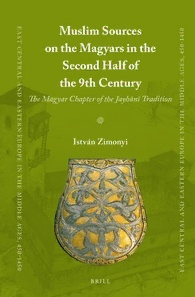
Muslim Sources on the Magyars in the Second Half of the 9th Century: The Magyar Chapter of the Jayhānī Tradition PDF
Preview Muslim Sources on the Magyars in the Second Half of the 9th Century: The Magyar Chapter of the Jayhānī Tradition
MuslimSourcesontheMagyarsintheSecondHalfofthe9thCentury East Central and Eastern Europe in the Middle Ages, 450–1450 GeneralEditor FlorinCurta volume35 Thetitlespublishedinthisseriesarelistedatbrill.com/ecee Muslim Sources on the Magyars in the Second Half of the 9th Century TheMagyarChapteroftheJayhānīTradition By IstvánZimonyi leiden | boston Coverillustration:SabretacheplatefromKarosCemeteryII.CourtesyoftheOttóHermanMuseum (Miskolc,Hungary). LibraryofCongressCataloging-in-PublicationData Names:Zimonyi,István.|Jayhānī,AḥmadibnMuḥammadibnNaṣr,active10thcentury. Title:MuslimsourcesontheMagyarsinthesecondhalfofthe9thcentury:theMagyarchapterofthe Jayhanitradition/byIstvanZimonyi. Othertitles:Muszlimforrásokahonfoglaláselőttimagyarokról.English Description:Leiden:Brill,2016.|Series:EastCentralandEasternEuropeintheMiddleAges,450-1450,ISSN 1872-8103;volume35|"TheHungarianversionofthepresentworkwascompletedinlate2003and publishedunderthetitleMuszlimforrásokahonfoglaláselőttimagyarokról:aĞayhānī-hagyomány magyarfejezete(MuslimsourcesontheMagyarsbeforetheConquest:theMagyarchapterofthe Jayhanitradition)"–Preface.|Includesbibliographicalreferencesandindex. Identifiers:LCCN2015032912|ISBN9789004214378(hardback:acid-freepaper)|ISBN9789004306110 (e-book) Subjects:LCSH:Hungary–History–To896–Sources.|Hungary–History–To896–Historiography.| Ethnology–Hungary–Earlyworksto1800.|Philology–Earlyworksto1800.|Hungarianphilology–Early worksto1800.|Jayhānī,AḥmadibnMuḥammadibnNaṣr,active10thcentury–Criticismand interpretation.|Geography,Medieval–Asia,Central–Earlyworksto1800.|Nomads–Asia, Central–History–To1500–Sources. Classification:LCCDB927.Z56132016|DDC943.9/01072–dc23LCrecordavailableat http://lccn.loc.gov/2015032912 Thispublicationhasbeentypesetinthemultilingual“Brill”typeface.Withover5,100characterscovering Latin,ipa,Greek,andCyrillic,thistypefaceisespeciallysuitableforuseinthehumanities.Formore information,pleaseseewww.brill.com/brill-typeface. issn1872-8103 isbn978-90-04-21437-8(hardback) isbn978-90-04-30611-0(e-book) Copyright2016byKoninklijkeBrillnv,Leiden,TheNetherlands. KoninklijkeBrillnvincorporatestheimprintsBrill,BrillHes&DeGraaf,BrillNijhoff,BrillRodopiand HoteiPublishing. Allrightsreserved.Nopartofthispublicationmaybereproduced,translated,storedinaretrievalsystem, ortransmittedinanyformorbyanymeans,electronic,mechanical,photocopying,recordingorotherwise, withoutpriorwrittenpermissionfromthepublisher. AuthorizationtophotocopyitemsforinternalorpersonaluseisgrantedbyKoninklijkeBrillnvprovided thattheappropriatefeesarepaiddirectlytoTheCopyrightClearanceCenter,222RosewoodDrive, Suite910,Danvers,ma01923,usa.Feesaresubjecttochange. Thisbookisprintedonacid-freepaper. Contents Preface ix ListofMapsandIllustrations xiii Introduction 1 1 TheJayhānīTradition 7 1 ThePersonalityofal-Jayhānī 7 2 Al-Jayhānī’sLiteraryActivityandHisGeographicalWork 11 3 TheSourcesofal-Jayhānī’sGeographicalWork 16 IbnKhurdādhbih 16 4 TheWorksWhichPreservedtheJayhānīTradition 18 IbnRusta 18 Ḥudūdal-ʿālam 19 Gardīzī 19 Al-Bakrī 20 Abūʾl-Fidāʾ 23 Al-Marwazī 23 ʿAwfī 24 Shukrallāh 24 MuḥammadKātib 25 ḤājjīKhalīfa 25 5 Al-Jayhānī’sReportonCentralAsiaandEasternEurope 26 2 TheVersionsandTranslationsoftheMagyarChapter 38 3 TheInterpretationoftheMagyarChapter 56 1 TheNameoftheMagyars 56 FolkEtymologiesoftheDesignationMagyar 62 2 TheEasternMagyars 67 Pechenegs 67 VolgaBulgars 72 Äskäl 74 FirstBorder 77 3 TheMagyarsasTurks 83 TurkMeaningMagyar 85 MagyarsBelongingtotheTurkPeoples 90 4 TheStrengthoftheMagyarArmy 102 vi contents 5 ThePoliticalOrganization 116 TheInterpretationoftheWordshiʿār 117 TheMagyarKingKündä 118 TheKingGyula 120 DualKingship 120 TheStructureofNomadicEmpires 125 6 HousesandNomadicLife 139 YurtsandTents 139 NomadicWayofLife 160 7 TheDimensionsoftheMagyarLands 186 8 TheSeaofRūmandItsTwoRivers,FishingintheWinter Quarters 202 TheRomanSea 204 JayḥūnAmuDarya 230 WinterQuarters 233 Fishing 236 9 TheBulgarsontheDanube 239 Onogundur~W.n.nd.r 241 BulgarsandOgurs 244 DanubeBulgars 262 10 EtilandDanube 265 Danube 266 Volga 270 Etelköz,HabitatoftheMagyarsbeforetheConquest 281 TheRoleofRiversintheNomadicWayofLife 284 11 Moravia 290 12 TheCharacteristicoftheMagyarLands 303 13 MagyarAgriculture 306 14 MagyarsandSlavs 309 Ṣaqāliba 317 Rūs 320 KievandtheMagyars 324 Provisions 327 15 TheReligionoftheMagyars 330 16 Magyar-ByzantineTrade 334 Karkh 336 SlaveTrade 337 ByzantineMerchandise 338 17 Khazar-MagyarRelations 340 Sarkel 340 contents vii Trench 342 Khazar-MagyarRelations 344 18 TheAppearanceoftheMagyars 354 19 ClothesandWeapons 356 Weapons 357 20 ProsperityandTrade 358 21 RaidsagainsttheSlavs 359 22 TheDistancebetweentheSlavsandtheMagyars 359 23 Bride-Price 360 24 TheEasternBorderoftheMagyarTerritory 363 25 SlavicCastlesagainsttheMagyars 364 Summary 365 Bibliography 377 Index 409 Preface The Hungarian version of the present work was completed in late 2003 and publishedunderthetitleMuszlimforrásokahonfoglaláselőttimagyarokról.A Ğayhānī-hagyománymagyarfejezete(MuslimsourcesontheMagyarsbefore theConquest.TheMagyarchapteroftheJayhānītradition).1Itwasthentrans- lated into German and published in Herne in 2006. During the preparation of the English translation, I took into consideration the critical notes of the reviewspublishedinthemeantime.2 IalsodrewinspirationfromthepublicationofMihályKmoskó’sstudieson themedievalnomadicpeoplesoftheEurasiansteppe,inwhichtherelevant textsoftheMuslimgeographicalandhistoricalliteraturehadbeencollected andtranslated.Ihadplannedtopublishhismanuscriptswithacommentary reflectingthestateofresearchintheearly1990s,buteventuallydecidedtosepa- ratethetwoprojects.Meanwhile,Kmoskó’sstudiesontheMuslimgeographical literaturehavebeenpublishedinthreevolumes.3 1 Hereandinthefollowingpages,Iusetheterm“Magyars”forthenomadic,pagantribalcon- federacyledbytheMagyartribeinthe9th–10thcenturiesandemploy“Hungarians”eitherfor theChristianMagyarsafterad1000,orforallsubsequentperiodstothemodernday.Infact, “Magyar”isaself-designation,while“Hungarian”ultimatelyderivesfromtheLatin“Ungri” or“Hungri,”whichitselfgoesbacktotheSlavic“Ongur.”TheSlavictermsshowsthatspeak- ersofSlavicsawtheMagyarsasOnogursandcalledthembythatethnicname.Besidesthis distinctionbetweenaself-designationandthenameemployedbyoutsiders,thatbetween MagyarandHungarianisnotdevoidofseriousproblems,asitmayattimesimplythatthe MagyarsandtheHungariansweretwoseparateidentities.Nonetheless,thekingdomwhich theMagyarsestablishedafterconversionwasknownasHungariainLatinsources,although theMagyars,whowerethedominantelementinthatkingdomthroughoutitshistory,pre- servednotonlytheirethnicidentityandlanguage,butalsotheirownself-designationtothis day.Tocomplicatethingsevenfurther,theconversiontoChristianityandtheaccompany- ingsocialandpoliticalchangesalsointroducedanewterritorialconcept:AHungarianwas apersonbornintheHungarianChristianKingdom,whowasthesubjectoftheHungarian king.Theethnicandterritorialconceptswereinparalleluseforthesubsequentcenturies (Zimonyi1994a,5–7). 2 FerencMakk,“UnemonographiesurlesHongroisdelapériodeprécédantl’occupationdu bassincarpatique,”Chronica6(2006):52–65;EmineYılmaz,inBiligTürkDünyasıSosyalBil- imlerDergisi,Güz2007,224–228;ImmoEberl,inZeitschriftfürSiebenbürgischeLandeskunde 31(2008):165–166;VictorSpinei,inSüdost-Forschungen67(2008):419–424;FlorinCurta,in ArchivumEurasiaeMediiAevi16(2008–2009):285–287. 3 Kmoskói/1,i/2,i/3.
